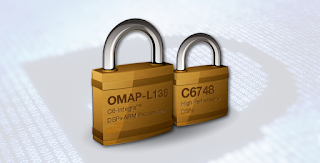Texas Instruments has announced new secure boot and encryption features for users of the company's TMS320C6748 digital signal processors (DSPs) and OMAP-L138 DSP + ARM® processors. These processors are part of TI’s C6000™ DSP and C6-Integra™ DSP + ARM product platforms.
TI says that designers can use the secure boot capability to stop external entities from modifying proprietary algorithms, to prevent unauthorized system access, insertion of malware, reverse engineering and system cloning.
With multi-layer encryption you can upgrade boot and application software code remotely on flash memory while keeping your boot sequence secure. To enable multi-layer encryption you install a device-specific cipher key that will be "known" only to the device. When an update is needed, you create a new encrypted image by using the device encryption keys. The device can then acquire the image wirelessly and overwrite the existing code.
TI suggests that examples of applications that would benefit from the secure boot and secure field upgrade feature include medical patient monitors that utilize proprietary, certified algorithms and software-defined radios (SDRs) to ensure communication isn’t compromised if the radios fall into the wrong hands.
Designers can utilize a low power sleep mode in the TI devices. The C6748 DSP is specified for 420mW total power and 11 mW in sleep mode in common use cases, while the OMAP-L138 specification is 480mW total power and 11mW in sleep mode.
Peripheral functions in the TI devices include:
- uPP (Universal parallel port)
- EMAC (ethernet MAC - media access controller)
- SATA (serial advanced technology attachment )
- MMC/SD (multimedia card/secure digital)
- high-speed USB 2.0/1.1 (universal serial bus)
- video port interface
- LCD controller
TI says that designers can use the uPP to implement high-speed connections to data converters, FPGAs or other processors. By applying the EMAC, SATA and MMC/SD ports you can enable desktop, network or portable connectivity or storage.
Pricing and availability
The secure boot, multi-level encrypted C6748 DSPs and OMAP-L138 DSP + ARM processors are sampling today at 375MHz and 456MHz with industrial temperature ranges available. Production pricing starts at $18 per 1,000 units (1ku) for the C6748 DSP and $21.40 per 1ku for the OMAP-L138 DSP + ARM processor. TI also offers secure-boot-enabled devices in the C5000™ ultra-low-power DSP platform and plans to introduce future software-compatible devices with varying levels of security in additional DSP, DSP + ARM and ARM-only platforms.
Related article: AMCC embeds security features in network processor SoC


No comments:
Post a Comment